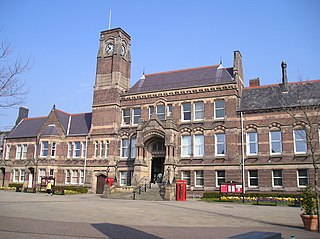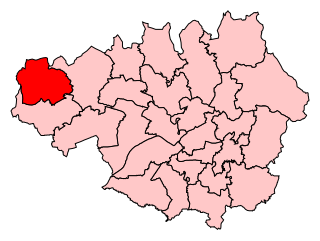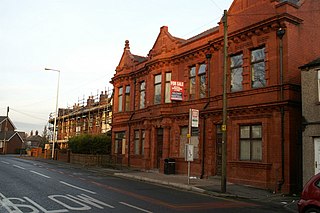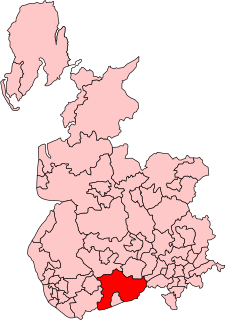Related Research Articles

Newton-le-Willows is a market town in the Metropolitan Borough of St Helens, Merseyside, England. The population at the 2011 census was 22,114. Newton-le-Willows is geographically located between Manchester and St. Helens.

Ashton-in-Makerfield is a market town in Greater Manchester, England. It is part of the Metropolitan Borough of Wigan and is 4.2 miles (6.8 km) south of the town of Wigan. In 2001 it had a population of 28,505, increasing to 28,762 at the 2011 Census.

Elmet, sometimes Elmed or Elmete, was an independent Brittonic kingdom between about the 5th century and early 7th century, in what later became the smaller area of the West Riding of Yorkshire then West Yorkshire, South Yorkshire and North Derbyshire.

The Metropolitan Borough of Wigan is a metropolitan borough of Greater Manchester, in North West England. It is named after the former county borough and includes the towns and villages of Wigan, Leigh, part of Ashton-in-Makerfield, Abram, Ince-in-Makerfield, Hindley, Orrell, Standish, Atherton, Tyldesley, Golborne, Lowton, part of Billinge, Astley, Haigh and Aspull. The borough was formed in 1974 and is an amalgamation of several former local government districts and parishes. The borough has three civil parishes and lies directly to the west of the City of Salford and southwest of the Metropolitan Borough of Bolton. The local authority is Wigan Metropolitan Borough Council.

The Metropolitan Borough of St Helens is a metropolitan borough of Merseyside, in North West England. It is named after its largest town St Helens, and covers an area which includes the settlements of Earlestown, Rainhill, Eccleston, Clock Face, Haydock, Billinge, Rainford and Newton-le-Willows.

Haydock is a large village within the Metropolitan Borough of St Helens, in Merseyside, England. Historically in Lancashire, it contains all of the Haydock electoral ward and a section of the Blackbrook electoral ward. The village is located roughly midway between Liverpool and Manchester, and contains the junction of the M6 motorway and the A580. At the 2001 Census, the village had a population of 11,962, reducing to 11,416 at the 2011 Census.

Orrell is a ward of the Metropolitan Borough of Wigan, Greater Manchester, England. The population of the ward had fallen at the 2011 Census to 11,513. The centre of the area lies 3 miles (4.8 km) to the west of Wigan town centre and serves as a predominantly residential suburb of Wigan. The area is contiguous with the district of Pemberton.

Hindley is a town within the Metropolitan Borough of Wigan in Greater Manchester, England. Lying three miles (4.8 km) east of Wigan it covers an area of 2,580 acres (1,044 ha). Historically in Lancashire, Hindley borders the towns of Ince-in-Makerfield, Aspull, Westhoughton, Atherton and Westleigh in the former borough of Leigh. In 2001, Hindley had a population of 23,457, increasing to 28,000 at the 2011 Census. It forms part of the wider Greater Manchester Urban Area.

Bryn is a component ward of the Metropolitan Borough of Wigan, Greater Manchester, England. It is part of the larger town of Ashton-in-Makerfield and is geographically indistinguishable from it, but forms a separate local council ward. The population of this ward at the 2011 census was 11,662. Served by Bryn railway station, Bryn is home to the Three Sisters Recreation Area which has been created from three large spoil tips which remain from Bryn's role in Lancashire's coal mining past. The recreation area is also the site of the Three Sisters Race Circuit, which provides race driving instruction and plays host to kart racing events and motorcycle road race meetings at clubman level.

Makerfield is a constituency represented in the House of Commons of the UK Parliament since 2010 by Yvonne Fovargue of the Labour Party.

Wigan is a constituency in Greater Manchester, represented in the House of Commons of the UK Parliament since 2010 by Lisa Nandy of the Labour Party, who also serves as the Shadow Foreign Secretary.

Abram is a village and electoral ward in the Metropolitan Borough of Wigan, Greater Manchester, England. It lies on flat land on the northeast bank of the Leeds and Liverpool Canal, 2 miles (3.2 km) west of Leigh, 3 miles (4.8 km) southeast of Wigan, and 14.5 miles (23 km) west of Manchester. Abram is a dormitory village with a population of 9,855.

The Greater Manchester Built-up Area is an area of land defined by the Office for National Statistics (ONS), consisting of the large conurbation that encompasses the urban element of the city of Manchester and the continuous metropolitan area that spreads outwards from it, forming much of Greater Manchester in North West England. According to the United Kingdom Census 2011, the Greater Manchester Built-up Area has a population of 2,553,379 making it the second most populous conurbation in the United Kingdom after the Greater London Built-up Area. This was an increase of 14% from the population recorded at the United Kingdom Census 2001 of 2,240,230, when it was known as the Greater Manchester Urban Area.

Ince-in-Makerfield or Ince is a town in the Metropolitan Borough of Wigan, in Greater Manchester, England. The population of the Ince ward at the 2011 census was 13,486, but a southern part of Ince was also listed under the Abram ward. Adding on this area brings the total in 2011 to 15,664.

Golborne is a town within the Metropolitan Borough of Wigan, in Greater Manchester, England. It lies 5.4 miles (8.7 km) south-southeast of Wigan, 6.1 miles (9.8 km) northeast of Warrington and 13.8 miles (22.2 km) to the west of the city of Manchester. Combined with the neighbouring town of Lowton, it has a population of 24,041.

Newton was a parliamentary borough in the county of Lancashire, in England. It was represented by two Members of Parliament in the House of Commons of the Parliament of England from 1559 to 1706 then of the Parliament of Great Britain from 1707 to 1800 and of the Parliament of the United Kingdom from 1801 until its abolition in 1832.
Luguvalium was a Roman town in northern Britain in antiquity. It was located within present-day Carlisle, Cumbria, and may have been the capital of the 4th-century province of Valentia.

Wigan is a large town in Greater Manchester, England, on the River Douglas, 10 miles (16 km) south-west of Bolton, 12 miles (19 km) north of Warrington and 16 miles (25.7 km) northwest of Manchester. Wigan is the largest settlement in the Metropolitan Borough of Wigan and its administrative centre. The town has a population of 103,608, and the wider borough of 318,100. Wigan is within the boundaries of the historic county of Lancashire.

Kenyon is a village in the civil parish of Croft in Warrington, Cheshire, England.
References
- 1 2 James, Alan. "A Guide to the Place-Name Evidence" (PDF). SPNS - The Brittonic Language in the Old North. Archived from the original (PDF) on 13 August 2017. Retrieved 25 November 2018.CS1 maint: discouraged parameter (link)
Coordinates: 53°30′N2°37′W / 53.500°N 2.617°W